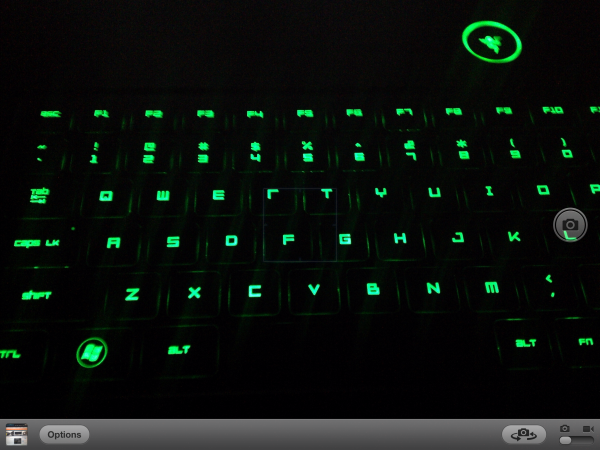The Apple iPad Review (2012)
by Vivek Gowri & Anand Lal Shimpi on March 28, 2012 3:14 PM ESTThe Camera, It's Much Improved
by Vivek Gowri
iOS 5.1 brought with it a number of bugfixes along with a few minor changes to the core entertainment applications (Music, Photos, Videos), but the only real UI change it brought was the redesigned camera application for the iPad. It fixes our biggest complaint with the original—the shutter button’s location in the middle of the settings bar at the bottom of the screen—and ends up being a big improvement from a usability standpoint. The shutter now resides in a floating circular button on the right side of the display, right where your right thumb falls when holding the iPad with two hands. It’s a more intuitive location for the shutter, so taking a picture is a far more natural feeling exercise than it was before. Other than that, the app looks pretty similar—the settings bar now has the still/video slider, front/rear camera switch, an options button, and the link to the photo gallery.
In terms of camera options, there’s only one. You can either have the rule of thirds grid overlay visible or hidden....and that’s it. There’s no other settings for you to change. No exposure, white balance, ISO, shutter speed, or anything else that isn’t the shutter button. Unfortunately, even the HDR mode from the 4 and 4S is nowhere to be found on the iPad. You literally just point and shoot. That’s all there is for you to do.
In our review of the iPad 2, we summed up the cameras with just one word, mediocre. Looking back, I realize now that the word mediocre is a pretty charitable way to describe the iPad 2’s camera situation. Both sensors were borrowed from the iPod touch, and while the VGA front facing camera was acceptable, the rear facing 720p camera was legitimately bad by the standards of a $499 device.
The new iPad fixes that rear camera problem in a big way, with the five element f/2.4 lens and optics borrowed from the iPhone 4S paired with the Omnivision OV5650 CMOS image sensor from the iPhone 4. A quick refresher on specs: 5 megapixels, backside illuminated, 1080p video at 60fps. If you ignore megapixel count, it’s a pretty competitive camera on paper. There’s a lot of recycled parts here, with bits and pieces from other iDevices frankensteined together to come up with a new imaging system for the iPad, but parts-bin raids aren’t bad when the bins being raided from contain top-tier components. The result ends up being pretty good—as a camera, the new iPad is light years ahead of its predecessor in basically every way.
In practice, it’s nothing short of stellar. Image quality is comparable to most high end smartphones, though not quite good enough to be on par with the bleeding edge cameraphones (4S, Nokia N8/N9, HTC Amaze 4G, Galaxy S 2, etc). Interestingly enough, the preview image looks to be running below 30 fps, appearing a little bit choppy at times. This is likely due to the high resolution of the preview and upscaling it to a very high display resolution, but it doesn’t particularly affect image capture. I measured shot to shot time at exactly one second (I had a range between 0.98 and 1.04 seconds, averaged out to 1.0 when factoring in reaction time). That’s about double what Apple claimed for the 4S, and a bit longer than the iPad 2. Granted, the iPad 2’s camera was very quick in part because the amount of processing it takes to capture a 960x720 image is almost zero, with about 13.8% as many pixels as each 2592x1936 image captured by the new iPad.
The focal length is 4.28mm, a bit longer than the iPad 2’s 3.85mm. The difference is actually noticeable; when taking pictures of nearby subjects, you’re sometimes surprised by how magnified the subject appears. However, the camera is good for landscapes, as you can see from the sample gallery. I took the iPad with me on a weekend trip to Victoria, B.C. and used it as my primary camera on the trip. Now, while I wouldn’t trade my SLR for an iPad anytime soon, I can’t deny that the results turned out pretty well. Colours were vibrant, white balance was accurate, and the clouds were nicely highlighted. It’s a quantum leap from the noisy, 0.7MP mess that was the iPad 2 camera. Mouse over the links below to see some comparisons between the cameras on the iPad 2, 3rd gen iPad and TF Prime.

| Apple iPad 2 | Apple iPad (3rd gen) | ASUS TF Prime |
| original | original | original |

| Apple iPad 2 | Apple iPad (3rd gen) | ASUS TF Prime |
| original | original | original |
The new sensor can record 1080p video, up from 720p. Video quality was probably the best aspect of the iPad 2 camera, and it's even better here. Output is recorded at 29.970 fps and encoded in h.264 Baseline with a bitrate of 21Mbps and single channel audio at 64kbps. The recorded video impresses, with crisp detailing and adequate audio quality from the single mic.
The front facing camera keeps the Omnivision OV297AA sensor from the iPad 2, and as such, image and video quality remain unchanged. It’s not necessarily a bad thing, since it remains adequate for FaceTime and Skype, but it would have been nice to see an update to an HD-quality webcam up front.
With augmented reality apps, I’m starting to see the benefit of rear cameras on tablets. For example, the Yelp app, which takes location and compass data to display what restaurants are the direction the iPad is pointing, with a real-time street view of the search results. It’s not necessarily the most useful way to use the rear facing camera in an AR application, but overall it’s an idea that has potential. Apple also tells us that its business and education customers see usefulness in the iPad's rear facing camera as they can use it to quickly document something while using the iPad as a productivity tool. As a consumer, you’re going to get weird looks if you’re using the iPad to take pictures though, it’s a relatively comical sight.
And that’s really the problem: from an ergonomic standpoint, smartphones are just so much easier and more comfortable to use as cameras. And because the imaging hardware is so similar, I’m not sure I see the real benefit of having a rear facing camera on a tablet except in very specific use cases.

























234 Comments
View All Comments
name99 - Friday, March 30, 2012 - link
Compared to the iPad1, the screen is, IMHO slightly smoother and a lot more oleophobic (ie it's a lot easier to clean off fingerprints by wiping a cloth over it). I never had an iPad2 so I don't know if these improvements are new or came with iPad2.shompa - Friday, March 30, 2012 - link
See = AppleTVTouch = Ipad.
But there was rumors about touch feedback from the screen. Probably in the next Ipad.
rakez - Friday, March 30, 2012 - link
as long as they stick with 4:3 i will never buy it.darkcrayon - Friday, March 30, 2012 - link
Similarly, that's one of the best things about the iPad. I can't see using a widescreen tablet in portrait mode, there is pretty much no popular content that works well there. On the other hand, 4:3 isn't as good for video, but the net effect is that the video is just smaller. I'll take properly positioned and scaled documents and smaller video over larger video and tiny documents.shompa - Friday, March 30, 2012 - link
You know that 16:9 is interesting if movies is the only thing you want to do.If you want to work on a tablet 16:9 does not work. You cant use landscape mode and see enough of the screen when you type. The 4:3 sceen is a bold move against tech nerds. I bet you are one of the tech nerds that screems when there are black bars on the side on you 16:9 TV. "why aren't the TV shows using the whole screen".
Then stupid TV people listen to you and crop 4:3 TV shows to fit 16:9 and cutting of large part of the picture.
The whole 16:9 debacle is actually a step backwards for the computing industry. Apple introduced widescreen displays early 2000. Steve made a great choose in 16:10. 2004 Apple invented the 2560x1600 screen. 16:10. Today its almost impossible to get a 16:10 screen. We all use TV LCDs for our computers = 16:9. 2560x1440. You loose 10% of real estate.
KoolAidMan1 - Saturday, March 31, 2012 - link
4:3 is better for web browsing and applications on a screen that size, the vertical room in landscape is great. It also makes for a much better balanced feel when holding it in portrait mode.Do you also like 16:9 on a desktop monitor? I sure don't, not unless it 27" 2560x1440
rakez - Saturday, March 31, 2012 - link
it's hard to argue with isheep and their products designed by god. i am pretty sure i know what i like more than someone else would know what i like. that being said, once again i prefer to not have 4:3 on my tablet. to each his own,Formul - Saturday, March 31, 2012 - link
starting with isheep and ending with "to each his own" ... you do love your bipolarity, don't you?rakez - Saturday, March 31, 2012 - link
sounds like i hit a nerve. go ahead keep following the herd. in the meantime i will buy what i want.PeteH - Monday, April 2, 2012 - link
Out of curiosity, what do you dislike about the 4:3 aspect ratio, and what's your preferred aspect ratio?